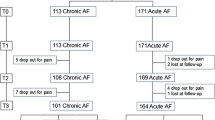Abstract
Fissure in ano is a very common disorder of the anorectal region. Internal sphincter hypertonia with decreased relaxation coupled with mucosal ischemia of posterior anal canal are the major pathologies in chronic anal fissure (CAF). Though lateral internal sphincterotomy (LIS) remains the gold standard of treatment for the disease, it is accompanied by the potential complication of incontinence to both flatus and faecal matter. The aim of our study was to explore the role of topical diltiazem as an effective and a safe alternative to sphincterotomy for chronic anal fissure. Ninety patients with CAF were randomly assigned to group A and group B, with 45 patients each. Group A patients received 2 % diltiazem topical application, twice daily, and group B patients underwent LIS. All the patients were reviewed at first, fourth and sixth week after initiation of treatment. Visual analogue scores for pain and healing of fissure by visual inspection were recorded and compared. In group A, 71 % had complete healing of fissure at 6 weeks, with fair amount of pain relief (mean VAS—3.38), and in group B, 96 % showed healing of fissure, with excellent pain relief (mean VAS—1.87). Headache and flushing were noted in two patients in group A while no patients in group B developed incontinence. We conclude that LIS is more effective than topical diltiazem in the treatment of CAF. Topical diltiazem may be employed as an initial conservative treatment option before considering the surgical alternative.
Similar content being viewed by others
References
Uwe W (2008) Pharmacological sphincterotomy for chronic anal fissures with the use of the botulinum toxin A. J Cutan Aesthet Surg 1:58–63
Jensen SL (1988) Diet and other risk factors for fissure-in-ano. A prospective case control study. Dis Colon Rectum 31:770–773
Rankinic J (2007) Anal fissure. Clin Colon Rectal Surg 20:133–138
Perry WB, Dykes SL, Buie WD, Rafferty JF (2010) Standards practice task force of the American Society of Colon and Rectal Surgeons Practice parameters for the management of anal fissures (3rd. revision). Dis Colon Rectum 53:1110–1115
Nelson RL, Chattopadhyay A, Brooks W, Platt I, Paavana T, Earl S (2011) Operative procedures for fissure in ano. Cochrane Database Syst Rev (11):Art. No.: CD002199. doi:10.1002/14651858.CD002199.pub4
Publications.nice.org.uk. 2013. ESUOM3: Chronic anal fissure: 2% topical diltiazem hydrochloride key… ESUOM3. [online] Available at: http://publications.nice.org.uk/esuom3-chronic-anal-fissure-2-topical-diltiazem-hydrochloride-esuom3. Accessed 13 Dec 2013
Schouten WR, Briel JW, Auwerda JJ (1994) Relationship between anal pressure and anodermal blood flow. Dis Colon Rectum 37:664–669
Schouten WR, Briel JW, Auwerda JJ, De Graaf EJ (1996) Ischaemic nature of anal fissure. Br J Surg 83:63–65
Nelson R (2009) Non surgical therapy for anal fissure. In: The cochrane library, issue 3. Wiley, Chichester
Cross KL, Massey EJDA, Fowler AL, Monson JRT (2008) The management of anal fissure: ACPGBI position statement. Colorectal Dis 10(Suppl 3):1–7
Nelson RL, Thomas K, Morgan J, Jones A (2012) Non surgical therapy for anal fissure. Cochrane Database Syst Rev (2):Art. No.:CD003431. doi:10.1002/14651858.CD003431.pub3
Nelson R (2010) Anal fissure (chronic). Clinical evidence; 03:407 BMJ Publishing Group Ltd
Yiannakopoulou E (2012) Botulinum toxin and anal fissure: efficacy and safety systematic review. Int J Color Dis 27:1–9
Brown CJ, Dubreuil D, Santoro L, Liu M, O’Connor BI, McLeod RS (2007) Lateral internal sphincterotomy is superior to topical nitroglycerin for healing chronic anal fissure and does not compromise long-term faecal continence: six-year follow up of a multicenter, randomized, controlled trial. Dis Colon Rectum 50:442–448
Karamanlis E, Michalopoulos A, Papadopoulos V et al (2010) Prospective clinical trial comparing sphincterotomy, nitroglycerin ointment and xylocaine/lactulose combination for the treatment of anal fissure. Tech Coloproctol 14:S21–S23
Perry WB, Dykes SL, Buie WD, Rafferty JF (2010) Practice parameters for the management of anal fissures (3rd revision). Dis Colon Rectum 53:1110–1115
Griffin N, Acheson AG, Jonas M, Scholefield JH (2002) The role of topical diltiazem in the treatment of chronic anal fissures that have failed glyceryl trinitrate therapy. Colorectal Dis 4:430–435
Shrivastava UK, Jain BK, Kumar P, Saifee Y (2007) A comparison of the effects of diltiazem and glyceryl trinitrate ointment in the treatment of chronic anal fissure: a randomized clinical trial. Surg Today 37:482–485
Jawaid M, Masood Z, Salim M (2009) Topical diltiazem hydrochloride and glyceryl trinitrate in the treatment of chronic anal fissure. J Coll Phys Surg Pak 19:614–617
Abd Elhady HM, Othman IH, Hablus MA et al (2009) Long-term prospective randomised clinical and manometric comparison between surgical and chemical sphincterotomy for treatment of chronic anal fissure. S Afr J Surg 47(1):12–14
Sanei B, Mahmoodieh M, Masoudpour H (2009) Comparison of topical glyceryl trinitrate with diltiazem ointment for the treatment of chronic anal fissure: a randomized clinical trial. Acta Chir Belg 109:727–730
Sajid MS, Rimple J, Cheek E, Baig MK (2008) The efficacy of diltiazem and GTN for the medical management of chronic anal fissure: a meta-analysis. Int J Colorectal Dis 23:1–6
Siddique MI, Murshed KM, Majid MA (2008) Comparative study of lateral internal sphincterotomy versus local 0.2% glyceryl trinitrate ointment for the treatment of chronic anal fissure. Bangladesh Med Res Counc Bull 34:12–15
Liratzopoulos N, Efremidou EI, Papageorgiou MS, Kouklakis G, Moschos J et al (2006) Lateral subcutaneous internal sphincterotomy in the treatment of chronic anal fissure: our experience. J Gastrointest Liver Dis 15:143–147
Acknowledgments
The authors thank the Postgraduate Dean Academics, Prof. N. Ananthakrishnan and Vice Chancellor of Mahatma Gandhi Medical College & Research Institute for their support and all the residents and staff in the Department of Surgery.
Conflict of Interest
None.
Author information
Authors and Affiliations
Corresponding author
Rights and permissions
About this article
Cite this article
Vaithianathan, R., Panneerselvam, S. Randomised Prospective Controlled Trial of Topical 2 % Diltiazem Versus Lateral Internal Sphincterotomy for the Treatment of Chronic Fissure in Ano. Indian J Surg 77 (Suppl 3), 1484–1487 (2015). https://doi.org/10.1007/s12262-014-1080-z
Received:
Accepted:
Published:
Issue Date:
DOI: https://doi.org/10.1007/s12262-014-1080-z




